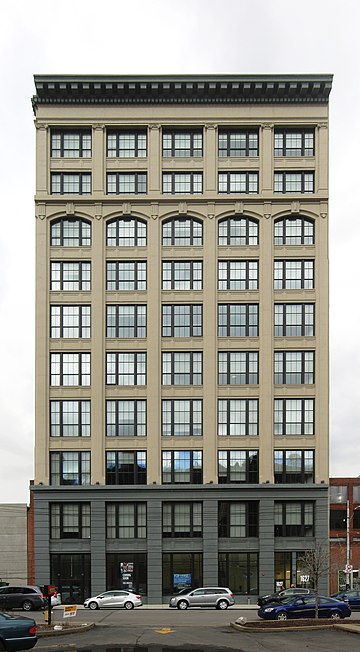
Old Main at Holy Ghost College, now Duquesne University, as it appeared in 1888.
Source: Allegheny County Centennial, a publication from which we’ll be featuring quite a few more pictures.

Old Main at Holy Ghost College, now Duquesne University, as it appeared in 1888.
Source: Allegheny County Centennial, a publication from which we’ll be featuring quite a few more pictures.

The Kaufmann’s building at Fifth and Smithfield was designed by Benno Janssen, who gave it a facing of ornate terra-cotta tiles. Compare these decorations to the similar ones on Janssen’s earlier Buhl Building farther down Fifth Avenue.

This 10-storey near-skyscraper in the Strip is a fine example of a commercial building from the early 1900s—in this case, 1906. It is in the process of turning into—what else?—luxury apartments.

A fine example of a Victorian cast-iron façade, nicely restored, on Liberty Avenue in the Cultural District.

A rainbow in the northeast, seen down West Liberty Avenue from the parking lot of Dormont Village. It is perhaps not the most poetical place to see a rainbow, but it was a very good rainbow, with the beginnings of another above it.


The Hamilton Building stood at 91 and 93 Fifth Avenue, which, if the addresses are the same, would put it right about where the May Building is now. The owner, a dealer in pianos and cottage organs, was obviously very proud of its astounding height. But the skyscraper age was about to begin, and in a few years this would be just another inconsiderable storefront downtown, soon to be replaced by a skyscraper itself.
Source: Allegheny County: Its Early History and Subsequent Development, 1888.

The prolific Charles Bickel designed this well-balanced Romanesque building, two doors up from another one of his Romanesque creations on Liberty Avenue, the Maginn Building. Below we see both of them in context, with, of course, a bus coming toward us, because old Pa Pitt likes to do that.


This ostentatious little building on Fifth Avenue is in need of some restoration. Something could be done with the ground floor to make it more in sympathy with the upper storeys without spending the immense fortune it would probably take to recreate the original classical front. Even a simple modernist glass front would be more harmonious.

Formerly One Oliver Plaza, this modernist block from 1968 was one of the last works of William Lescaze, pioneer of modernism, who died the next year. Old Pa Pitt confesses to not missing him a whole lot.